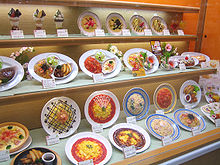Food model
It has been suggested that Fake food in Japan be merged into this article. (Discuss) Proposed since November 2015. |

Fake foods are made from various types of plastics, resins, and similar materials to replicate the appearance of real foods.
There are various names for fake food including pretend food, wax food, artificial food, faux food, replica food, imitation food, food replicas, false foods, food fakes, and simulated food.
History
During the early Shōwa period, following Japan’s surrender ending World War II in 1945, Americans and Europeans traveled to Japan to help with the rebuilding efforts. Foreign travelers had difficulties reading Japanese menus, so Japanese artisans and candle makers quickly developed plates of wax foods for restaurants that made it easy for foreigners to order something that looked appetizing.[1] Paraffin was used to create fake food until the mid-1980s; because its colors faded when exposed to heat or sunlight, manufacturers later switched to vinyl chloride, which is "nearly eternal."[2]
Modern use

Fake foods are used in many ways, such as props for backgrounds in movies, television shows, theatrical plays, television commercials, print ads, and trade shows. Fake foods are also used to display lifelike replicas of real foods for restaurants, grocery chains, museums, banquet halls, casino buffets, cruise ships, and in many other instances in which real foods cannot be displayed. For instance, the American company Fake Foods began when fast food restaurant Wendy's needed fake kale for their salad bar display.[3]
In the 2010s, fake foods were also used for nutrition education and consumer research.[4][5] [6]
In North America, fake food is often used for retail displays. Furniture retailers use it in showrooms (e.g., a bowl of fake apples) to give their furniture settings a lived-in look.
Many restaurants in Japan use fake foods to display their popular dishes in their windows and attract customers. The plastic replicas are much more expensive than the food they imitate, but can last indefinitely. For this reason, many companies that manufacture fake food have stagnant or declining profits.[7]
Other meanings
An emerging meaning of the term fake food is a popular substitute for the more scientific term pseudofood, or pseudobezoar, an indigestible object introduced intentionally into the digestive system,[8] which takes space in the stomach so that dieters feel full, eat little, and lose weight.
Manufacturing process
Today’s manufacturing technologies and high quality plastic materials provide realistic-looking fake food replicas, and approximately 95% of all fake food is still handcrafted. Artisans and highly trained craftsmen make realistic fake food, often painting them by hand to create a realistic look and feel. Some Japanese fake food manufacturers mimic the actual cooking process, employing chef's knives to chop plastic vegetables and real hot oil to fry plastic shrimp.[9]
At the beginning of the production process, real food is dipped in silicone to create a mold. A liquid plastic of the correct color, typically vinyl chloride, is poured into the mold, then heated in an oven until it solidifies.[1] When a food is not available or it would disintegrate or melt in the mold while the mold is setting up, a clay model of the food must be sculpted first. After setting for ten to thirty minutes, any excess vinyl buildup is trimmed off. Next, the replica is painted either by hand or airbrush. If the food has many parts, such as a hamburger or sushi roll, the item is assembled from many vinyl pieces.[2]
See also
References
- ^ a b Hani, Yoko (November 24, 2002), "A feast for the eyes", Japan Times
- ^ a b Fukuda, Natsuki, "Delicious Vinyl: Japan's Plastic Food Replicas", Sake-Drenched Postcards
- ^ Cook, Kristen (1 April 2009), "Mouth-watering plastic: Fake foods save businesses real dollars annually", Arizona Daily Star
- ^ Bucher T, van der Horst K, Siegrist M, (16 September 2011). "The fake food buffet – a new method in nutrition behaviour research". Br J Nutr. 107: 1–8. doi:10.1017/S000711451100465X. PMID 21920063.
{{cite journal}}: CS1 maint: extra punctuation (link) CS1 maint: multiple names: authors list (link) - ^ Bucher T, Müller B, Siegrist M, (1 December 2015). "What is healthy food? Objective nutrient profile scores and subjective lay evaluations in comparison". Appetite. 95: 408–14. doi:10.1016/j.appet.2015.08.005. PMID 26256557.
{{cite journal}}: CS1 maint: extra punctuation (link) CS1 maint: multiple names: authors list (link) - ^ Libotte E, Siegrist M, Bucher T (Nov 2014). "The influence of plate size on meal composition. Literature review and experiment". Appetite. 82: 91–96. doi:10.1016/j.appet.2014.07.010. PMID 25049139.
{{cite journal}}: CS1 maint: multiple names: authors list (link) - ^ "Hungry Days For Fake-Food Firms: Profits Fall For Japan's Innovators", Seattle Times, January 2, 1994
- ^ Mintchev MP, Deneva MG, Aminkov BI, Fattouche M, Yadid-Pecht O, Bray RC (1 February 2010). "Pilot study of temporary controllable gastric pseudobezoars for dynamic non-invasive gastric volume reduction". Physiol. Meas. 31 (2): 131–44. doi:10.1088/0967-3334/31/2/001. PMID 20009188.
{{cite journal}}: CS1 maint: multiple names: authors list (link) - ^ McNicol, Tony (October 2008), "Good Enough to Eat" (PDF), Wingspan
